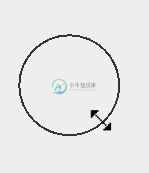感测悬停在JPanel中Path2D圆的外边缘上[重复]
所以,我有一个程序可以在JPanel上绘制Path2D圆。我试图做的是当用户点击并拖动圆圈右下角时调整圆圈的大小。所以,我想要检测的是它们何时在圆的右下角外边缘,而不是圆周围边界的右下角。基本上,我需要弄清楚如何做这样的事情:

我知道如何使用getBounds()来处理矩形,但是当您在圆上使用getBounds()时,它将返回圆周围的正方形,而不是实际圆的边界。有什么办法可以让它工作吗?谢谢
这是我的程序的一个缩短的可运行版本:
import java.awt.BasicStroke;
import java.awt.Color;
import java.awt.Graphics;
import java.awt.Graphics2D;
import java.awt.Panel;
import java.awt.Rectangle;
import java.awt.event.MouseAdapter;
import java.awt.event.MouseEvent;
import java.awt.geom.Ellipse2D;
import java.awt.geom.Path2D;
import java.util.ArrayList;
import java.util.List;
import javax.swing.JFrame;
import javax.swing.JPanel;
public class Editor {
public static void main(String[] args) {
JFrame frame = new UMLWindow();
frame.setDefaultCloseOperation(JFrame.EXIT_ON_CLOSE);
frame.setBounds(30, 30, 1000, 700);
frame.getContentPane().setBackground(Color.white);
frame.setVisible(true);
frame.setLocationRelativeTo(null);
frame.setVisible(true);
}
}
class UMLWindow extends JFrame {
Shapes shapeList = new Shapes();
Panel panel;
private static final long serialVersionUID = 1L;
public UMLWindow() {
addMenus();
panel = new Panel();
}
public void addMenus() {
getContentPane().add(shapeList);
setSize(300, 200);
setLocationRelativeTo(null);
setDefaultCloseOperation(EXIT_ON_CLOSE);
shapeList.addCircle(100, 100);
}
}
// Shapes class, used to draw the shapes on the panel
// as well as implements the MouseListener for dragging
class Shapes extends JPanel {
private static final long serialVersionUID = 1L;
private List<Path2D> shapes = new ArrayList<Path2D>();
int currentIndex;
public Shapes() {
MyMouseAdapter myMouseAdapter = new MyMouseAdapter();
addMouseListener(myMouseAdapter);
addMouseMotionListener(myMouseAdapter);
}
public void addCircle(int width, int height) {
Path2D circ = new Path2D.Double();
circ.append(new Ellipse2D.Double(442, 269, width, height), true);
shapes.add(circ);
repaint();
}
@Override
protected void paintComponent(Graphics g) {
super.paintComponent(g);
Graphics2D g2 = (Graphics2D) g;
g2.setStroke(new BasicStroke(2));
for (Path2D shape : shapes) {
g2.draw(shape);
}
}
class MyMouseAdapter extends MouseAdapter {
@Override
public void mousePressed(MouseEvent e) {
}
@Override
public void mouseDragged(MouseEvent e) {
}
@Override
public void mouseReleased(MouseEvent e) {
}
}
}
共有2个答案
不确定这是否有效,但您可以尝试以下方法:
- 创建一个比原始形状小几个像素的形状圆
你会想刷一下你的trig(或者像我一样谷歌搜索;))。基本概念是“相对”容易,但我为我的所有工作创造了一个很好的方法...
这种方法。。。
public Point2D getPointOnEdge(float angel, Rectangle bounds) {
float radius = Math.max(bounds.width, bounds.height) / 2;
float x = radius;
float y = radius;
double rads = Math.toRadians((angel + 90));
// Calculate the outter point of the line
float xPosy = (float) (x + Math.cos(rads) * radius);
float yPosy = (float) (y + Math.sin(rads) * radius);
return new Point2D.Float(xPosy + bounds.x, yPosy + bounds.y);
}
将计算给定角度将出现在圆上的x/y点,请记住,这仅适用于圆!
然后我用另一种方法。。。
public Rectangle2D getActiveBounds(float angel, Rectangle bounds) {
Point2D p = getPointOnEdge(angel, bounds);
return new Rectangle2D.Double(p.getX() - 4, p.getY() - 4, 8, 8);
}
为了计算“鼠标区域”,我认为它是底部/正确的区域,导致单个像素很难找到,并且简单地使用<代码>矩形>包含< /代码>,传递它当前的鼠标位置…
import java.awt.BasicStroke;
import java.awt.Color;
import java.awt.EventQueue;
import java.awt.Graphics;
import java.awt.Graphics2D;
import java.awt.Panel;
import java.awt.Point;
import java.awt.Rectangle;
import java.awt.event.MouseAdapter;
import java.awt.event.MouseEvent;
import java.awt.geom.Ellipse2D;
import java.awt.geom.Path2D;
import java.awt.geom.Point2D;
import java.awt.geom.Rectangle2D;
import java.util.ArrayList;
import java.util.List;
import javax.swing.JFrame;
import static javax.swing.JFrame.EXIT_ON_CLOSE;
import javax.swing.JPanel;
import javax.swing.UIManager;
import javax.swing.UnsupportedLookAndFeelException;
public class Editor {
public static void main(String[] args) {
new Editor();
}
public Editor() {
EventQueue.invokeLater(new Runnable() {
@Override
public void run() {
try {
UIManager.setLookAndFeel(UIManager.getSystemLookAndFeelClassName());
} catch (ClassNotFoundException | InstantiationException | IllegalAccessException | UnsupportedLookAndFeelException ex) {
ex.printStackTrace();
}
JFrame frame = new UMLWindow();
frame.setDefaultCloseOperation(JFrame.EXIT_ON_CLOSE);
frame.setBounds(30, 30, 1000, 700);
frame.getContentPane().setBackground(Color.white);
frame.setVisible(true);
frame.setLocationRelativeTo(null);
frame.setVisible(true);
}
});
}
public static class UMLWindow extends JFrame {
Shapes shapeList = new Shapes();
Panel panel;
private static final long serialVersionUID = 1L;
public UMLWindow() {
addMenus();
panel = new Panel();
}
public void addMenus() {
getContentPane().add(shapeList);
setSize(300, 200);
setLocationRelativeTo(null);
setDefaultCloseOperation(EXIT_ON_CLOSE);
shapeList.addCircle(100, 100);
}
}
// Shapes class, used to draw the shapes on the panel
// as well as implements the MouseListener for dragging
public static class Shapes extends JPanel {
private static final long serialVersionUID = 1L;
private List<Path2D> shapes = new ArrayList<Path2D>();
int currentIndex;
private Point mousePoint;
public Shapes() {
MyMouseAdapter myMouseAdapter = new MyMouseAdapter();
addMouseListener(myMouseAdapter);
addMouseMotionListener(myMouseAdapter);
}
public void addCircle(int width, int height) {
Path2D circ = new Path2D.Double();
circ.append(new Ellipse2D.Double(442, 269, width, height), true);
shapes.add(circ);
repaint();
}
@Override
protected void paintComponent(Graphics g) {
super.paintComponent(g);
Graphics2D g2 = (Graphics2D) g;
g2.setStroke(new BasicStroke(2));
for (Path2D shape : shapes) {
g2.setColor(Color.BLACK);
g2.draw(shape);
g2.setColor(Color.RED);
Rectangle2D bottomRight = getActiveBounds(-45, shape.getBounds());
g2.draw(bottomRight);
if (mousePoint != null) {
if (bottomRight.contains(mousePoint)) {
g2.fill(bottomRight);
}
}
}
}
public Rectangle2D getActiveBounds(float angel, Rectangle bounds) {
Point2D p = getPointOnEdge(angel, bounds);
return new Rectangle2D.Double(p.getX() - 4, p.getY() - 4, 8, 8);
}
public Point2D getPointOnEdge(float angel, Rectangle bounds) {
float radius = Math.max(bounds.width, bounds.height) / 2;
float x = radius;
float y = radius;
double rads = Math.toRadians((angel + 90));
// Calculate the outter point of the line
float xPosy = (float) (x + Math.cos(rads) * radius);
float yPosy = (float) (y + Math.sin(rads) * radius);
return new Point2D.Float(xPosy + bounds.x, yPosy + bounds.y);
}
class MyMouseAdapter extends MouseAdapter {
@Override
public void mouseMoved(MouseEvent e) {
mousePoint = e.getPoint();
repaint();
}
}
}
}
这个例子做了所有的工作在油漆方法,因为我想看到的效果区域,你可以很容易地使用相同的逻辑来改变鼠标光标内的MouseMoitionListener
-
问题内容: 因此,当我在JPanel上单击并拖动Path2D圆时,它正在调整大小。该 问题是,当我最初点击和拖动它,圆跳转到一个 更小的尺寸,但是当你单击并拖动,然后正确地调整大小。 演示的最简单方法是运行下面的可运行代码。 我知道我需要修复此代码: 我不确定如何。我单击圆的外边缘,然后将圆的边界的长度和宽度设置为新鼠标点所在的位置…但是我需要做的是 圆的坐标的外边缘新的鼠标点。关于如何计算正确点
-
我有一个“用户”顶点,其中有几个用户。我有一个“邀请”顶点,它基本上讲述了一个用户发送给另一个用户的邀请。我有一个“sentTo”边,将邀请顶点与用户顶点(邀请的接收者)连接起来。我有一个“sentBy”边,将邀请顶点连接到用户顶点(发送邀请的用户)。sentBy edge有一个“on”属性,它是一个日期对象。sentBy edge还具有“inviterCount”属性,基本上是收件人用户(接收邀
-
Canny边缘检测用于检测图像中的边缘。 它接受灰度图像作为输入,并使用多级算法。可以使用类的方法在图像上执行此操作,以下是此方法的语法。 该方法接受以下参数 - image - 表示此操作的源(输入图像)的对象。 edges - 表示此操作的目标(边缘)的对象。 threshold1 - 类型为的变量表示滞后过程的第一个阈值。 threshold2 - 类型为的变量表示滞后过程的第二个阈值。 示
-
我几乎没有图像处理和识别的背景知识。我试图检测灰度图像(如肖像)上的主边缘/灰度变换。问题是在某些部分,边缘模糊(因为焦点)。我使用的是具有多个阈值的Canny边缘检测器,但我永远无法检测到这些边缘(下巴、衣服、耳朵、脸部侧面等) 边缘检测是正确的工具吗?谢谢
-
目标 在这一章中,我们将学习 Canny 边缘检测的概念 OpenCV 的 Canny 边缘检测函数:cv2.Canny() 理论基础 Canny边缘检测是一种流行的边缘检测算法。它是由 John F. Canny 于 1986 年开发的。它是一个多阶段算法,我们将学习每个阶段做了什么。 降噪 由于边缘检测容易受到图像中的噪声影响,因此首先要用5x5高斯滤波器去除图像中的噪声。我们在前面的章节已经
-
目标 在本章中,我们将学习 Canny边缘检测的概念 OpenCV函数: cv.Canny() 理论 Canny Edge Detection是一种流行的边缘检测算法。它由John F. Canny发明 这是一个多阶段算法,我们将经历每个阶段。 降噪 由于边缘检测容易受到图像中噪声的影响,因此第一步是使用5x5高斯滤波器消除图像中的噪声。我们已经在前面的章节中看到了这一点。 查找图像的强度梯度 然

